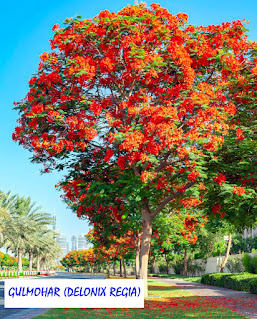Top 10 summer flowering trees in India
A wide variety of summer flowering trees can be found in India thanks to
its varied environment; each one enhances the landscape with its own special
beauty and ecological advantages. Here is a list of 15 of India’s most
well-known summer blooming trees:
1. Gulmohar (Delonix regia) –The Gulmohar, sometimes called the Flamboyant tree, Royal Poinciana, or
Delonix regia, is a stunning tropical tree that is well-known for its fern-like
leaves and bright crimson or orange-red blossoms. Although it originated in
Madagascar’s dry deciduous woodlands, its attractive appeal has led to its
widespread cultivation in tropical and subtropical locations worldwide.
2.
renowned for its breathtaking display of golden-yellow blossoms. Amaltas, often
called the Indian Laburnum or Golden Shower Tree, is native to Southeast Asia
and the Indian subcontinent.
3.
well-liked ornamental tree that is appreciated for its delicate, fern-like
leaves and stunning, long-lasting violet-blue blooms. Originating in South
America, specifically Brazil and Argentina, jacaranda trees are commonly grown
in tropical and subtropical climates worldwide.
4.
known as Butea monosperma, is a distinctive and important tree in terms of
culture. The Palash, sometimes called the Flame of the Forest, Dhak, or Tesu,
is well-known for its vibrant orange-red blooms that blossom profusely in the
spring.
5. Champa (Plumeria)- The tropical flowering tree known as champa, often called plumeria or
frangipani, is well-known for its fragrant and colorful blossoms.The topmost
prize of the tree are the champa flowers, which are prized for their stunning
beauty and scent. They are usually huge, with five petals that overlap, and
they can be red, pink, yellow, or white. The flowers are frequently utilized in
religious rituals, traditional garlands, and fragrance.
6. Pride of India (Lagerstroemia speciosa)- The Pride of India, which goes by the names Indian Lilac and Queen’s
Flower, are two distinct tree species that are indigenous to the Indian
subcontinent, each having its own special qualities.This plant, which is
indigenous to South Asia, which includes Bangladesh, Sri Lanka, and India, is a
member of the genus Lagerstroemia. It is a medium- to large-sized deciduous
tree with smooth gray bark and a wide, spreading crown.The tree is most
well-known for its enormous clusters of vivid purple-violet blooms that open in
the summer. The petals of the flowers are wrinkled, and they smell delicious. Simple,
elliptical leaves that become crimson before falling in the winter make up the
foliage.Because of their beautiful appearance, Pride of India trees are frequently
planted in parks, gardens, and along streets
7. Silk Cotton Tree (Bombax ceiba)- The beautiful tropical tree known as the Silk Cotton Tree, or Ceiba
pentandra in scientific parlance, is native to the tropical areas of Asia,
Africa, and the Americas. It is well-known for its commanding stature,
unusually enormous buttress roots for a trunk, and versatility in a range of
ecological and cultural settings.
8.
tropical tree that is indigenous to South and Southeast Asia. Because of its
importance to culture, religion, and ecology, it is highly respected.The tiny,
fragrant blooms that range in hue from yellow to orange on kadamba trees grow
in thick, spherical clusters called “Kadamba balls.” The scent of
these blooms is enticing and delicious.
9.
tropical tree that is highly valued for its colorful blooms and unique leaves.
It is found in many tropical and subtropical areas, especially in the Pacific
Islands, India, and Southeast Asia.The tree has beautiful, densely clustered
blooms that range in color from brilliant crimson to orange-red. The term comes
from the fact that each blossom is tubular and has a coral-like curving form.
Though it varies according on the locale, blooming usually takes place in late
winter or early spring, just before the leaves return.
10.
known as Saraca asoca (sometimes called Saraca indica), is a highly esteemed
and culturally significant tree. The “Sita Ashok” name sets it apart
from other species, such as the False Ashoka (Polyalthia longifolia). The tree
has fragrant, vivid orange-yellow to red blooms in thick clusters. It is
commonly referred to as simply Ashoka or Ashok tree. The tiny, four-petaled
blooms appear in big, eye-catching clusters, frequently sprouting straight from
the trunk and branches. The main months for blooming are February through
April.
